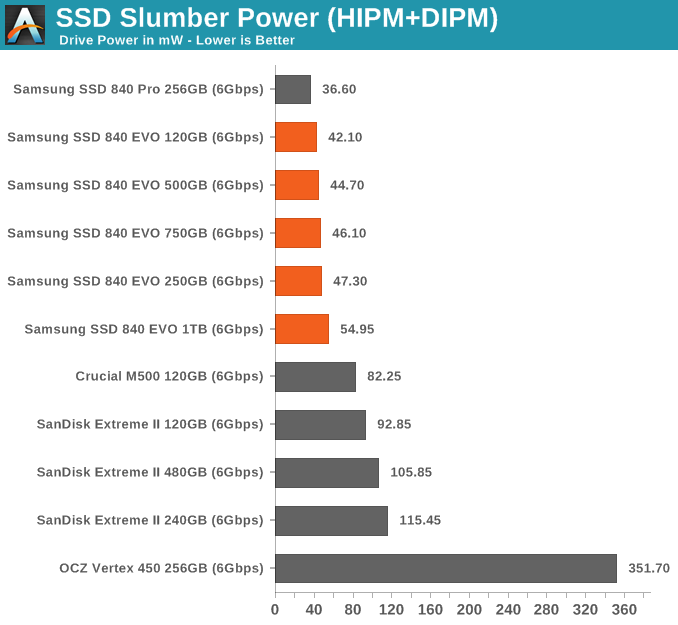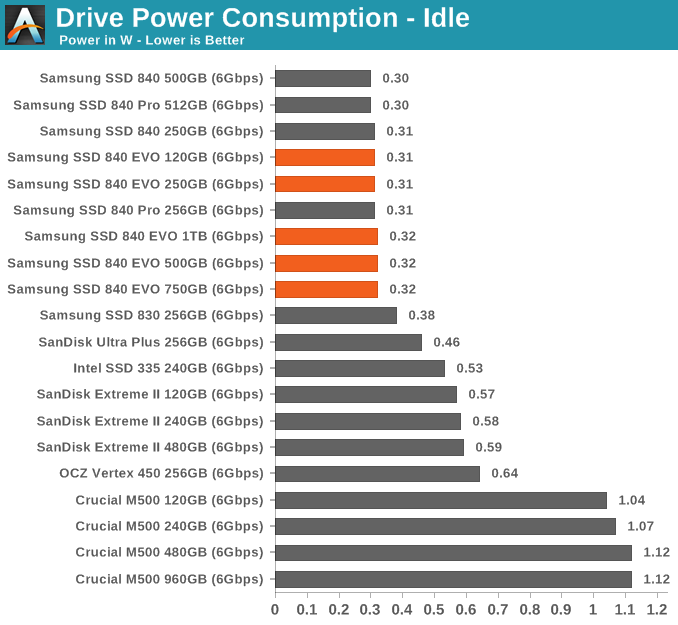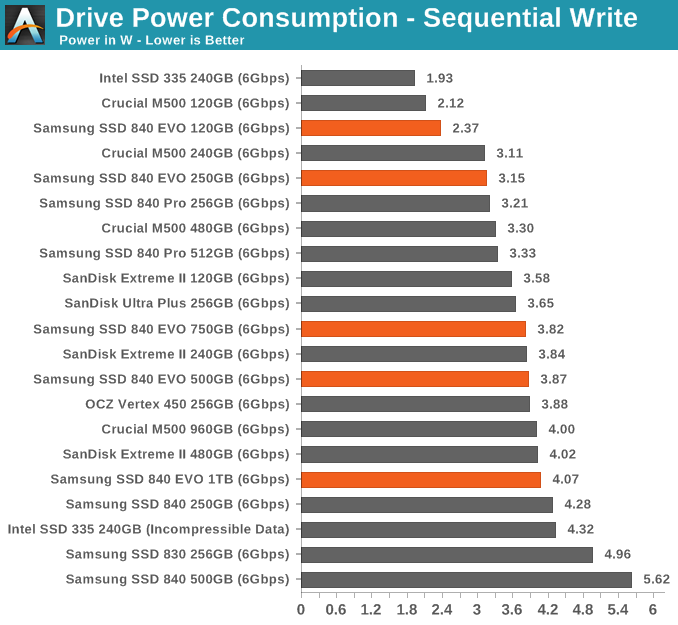Samsung SSD 840 EVO Review: 120GB, 250GB, 500GB, 750GB & 1TB Models Tested
by Anand Lal Shimpi on July 25, 2013 1:53 PM EST- Posted in
- Storage
- SSDs
- Samsung
- TLC
- Samsung SSD 840
Power Consumption
Low power consumption has always been a staple of Samsung's SSDs, and the EVO is no different. Idle and load power are among the best here. I'm also expanding our DIPM testing, first introduced in the SanDisk Extreme II review:
We're introducing a new part of our power consumption testing with this review: measurement of slumber power with host initiated power management (HIPM) and device initiated power management (DIPM) enabled. It turns out that on Intel desktop platforms, even with HIPM and DIPM enabled, SSDs will never go into their lowest power states. In order to get DIPM working, it seems that you need to be on a mobile chipset platform. I modified an ASUS Zenbook UX32VD to allow me to drive power to the drive bay from an external power supply/power measurement rig. I then made sure HIPM+DIPM were enabled, and measured average power with the drive in an idle state. The results are below:

The EVO is almost as good as the Pro from a slumber power perspective, and significantly better than anything else in the list here.













137 Comments
View All Comments
halbhh2 - Saturday, July 27, 2013 - link
Exactly. I found that even moving up from 8GB to 16GB had a great effect for me with an old Samsung F3 hard drive. The difference: after just 30 minutes from boot, loading an often used program like iTunes (for podcasts) was very similar to the speed on my laptop which has an 830 SSD and only 4GB. Both load in about 4 seconds, and the 16GB desktop loads so fast because it has had time to cache a lot of iTunes. Before the ram upgrade, that load time for iTunes on the desktop computer was about 14 seconds. Quite a difference due to windows 7 caching. The extra improvement I'd get from installing an SSD onto the desktop computer now would be modest, since I usually only need to reboot once or twice in a week. Still, the sweet spot of price/performance for me is approaching, probably around $60-$70, and that won't be long.Klimax - Sunday, July 28, 2013 - link
It's in wrong place. Unlike OS level caching (at least in Windows), which is in cooperation between memory manager, cache manager and file system driver, this is too low in the chain and sees only requests but nothing else and also takes memory from OS and takes too few.Coup27 - Thursday, July 25, 2013 - link
Typo: "although I wouldn't recommend deploying the EVO in a write heavy serve Microsoft's eDrive standard isn't supported at launch"Excellent article. Samsung continue to push SSDs and I'm really excited about RAPID. Is the 840 Pro due for a successor any time soon? I am selling my current ATX Sandy Bridge + 830 and getting a mITX Haswell + (840 Pro?) and want the fastest Samsung consumer SSD available and I'd be gutted to buy an 840 Pro to see it's successor released a few weeks later.
vLsL2VnDmWjoTByaVLxb - Thursday, July 25, 2013 - link
Another typo last page:"Even though its performnace wasn't class leading, it was honestly good enough to make the recommendation a no-brainer. "
JDG1980 - Thursday, July 25, 2013 - link
Will there be an 840 EVO Pro coming out later? To me, TLC is still a deal-breaker.By the way, what happens if power goes out during a TurboWrite (before the data has been written to the normal storage space)? Does this result in data loss, or, worse, bricking? I'd suspect Samsung at least avoided the latter, but I'd like to see some confirmation on this.
sherlockwing - Thursday, July 25, 2013 - link
I guess you didn't read the Endurance part of the review? Even if you write 100GiB a day all of those drives last longer than their warranty( 3 years), that's more than enough endurance.Coup27 - Thursday, July 25, 2013 - link
Some people just don't want to accept the facts. TLC could get to 99.9% of MLC endurance and people would still want MLC. I've been deploying 840's in a light duty enterprise environment and they've been fine. The only reason I use MLC at home is because I want the absolute fastest performance and I can afford it, not that I actually need it.Oxford Guy - Thursday, July 25, 2013 - link
The SanDisk Extreme 240 was just on sale for $150. TLC NAND still seems like a solution in need of a problem.Spunjji - Friday, July 26, 2013 - link
You can approach TLC pricing with an MLC drive in a sale, but the fact remains that when it comes to actual sustainable production pricing TLC NAND has a 50% density (and thus manufacturing cost advantage) over MLC. Given that NAND price determines drive cost and drive costs are the primary barrier of entry to SSDs, I'm fairly sure it has a problem to solve.FWIW I have not seen any drive touch the 120GB 840's price here in the UK, on sale or otherwise.
Oxford Guy - Friday, July 26, 2013 - link
However, there is also the problem of increasing latency and lifespan from node shrinkage.